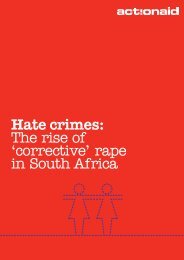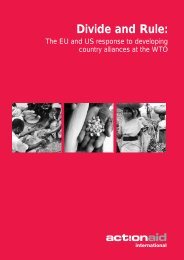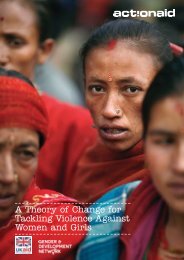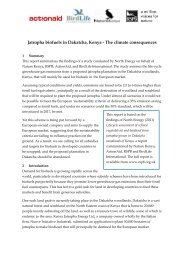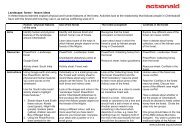A fair chance - United Nations Girls' Education Initiative
A fair chance - United Nations Girls' Education Initiative
A fair chance - United Nations Girls' Education Initiative
Create successful ePaper yourself
Turn your PDF publications into a flip-book with our unique Google optimized e-Paper software.
immediately arrested and upon inquiry, our strong andassertive demand was a school for girls .... By 1947, theNepal Mahila Singh [Nepal Women’s Association] hadbeen formed by a very large number of women with themajor objective of bringing about social and political changesthrough education. Therefore, ‘<strong>Education</strong> for Women’ wasits initial objective. By 1949, there was an [increasing] senseof responsibility among parents about sending girls to school.There was a mushroom growth of schools after democracywas established in 1951... (Belbase 1998: 187).However, the repression of civil society after 1960 puta damper on the women’s movement, and for the next30 years government action on girls’ education waslargely restricted to ‘lip service’ measures. Since thereinstatement of multi-party democracy in 1990,growing freedom of association has made space forcross-party groups such as the Women’s SecurityPressure Group (WSPG) to put pressure on theGovernment for policy reforms in all areas relevant towomen. Significant progress on girls’ enrolment andretention is finally being made. We return below tothe key importance of supporting and consultingindigenous advocates for gender equity and for theright to education.The international community’s renewed focus onpoverty reduction, and the World Bank and IMF’sshift from narrow macro-economic conditions towider policy conditions linked to the MillenniumDevelopment Goals, have also helped to ‘mainstream’gender inequality as a public policy problem.Box 7: Political commitment to basic education in BangladeshBangladesh is a good example of a country whose government – under pressure from women’s groups – has really bitten thepolitical bullet and taken decisive action on gender equity. Primary education was made compulsory by an act of parliamentin 1990. A substantially strengthened women’s movement helped to galvanise government commitment to abolishing theeducation gender gap. Their leverage was increased by the actions of international bodies, resulting in commitments towomen’s education and gender equity that were signed by the Government (Jahan 1998: 33–34).The Prime Minister launched the National Campaign for Social Mobilisation for Basic <strong>Education</strong> in 1992. Fees for rural girlswere abolished, free uniforms were distributed to girls (later discontinued) and food for education and stipend schemes werepiloted. Government spending on primary education began a significant upward trend.The Social Mobilisation campaign used multi-media techniques to spread the message, including a cartoon series called‘Meena’ highlighting the importance of education for poor girls. Simultaneously, the Ministry of Women’s Af<strong>fair</strong>s launched theBangladesh Decade Action Plan for the Girl Child, called ‘Samata’ (equality). The Action Plan identified the problems affectinggirls and women, and developed strategies to facilitate their access to basic education. It also prioritised actions needed witha focus on early childhood education as well as primary and secondary education and incentives for girls’ education.In the mid-1990s, satellite schools were started for Grade 1 and 2, fee-free education for girls was extended to Class 10, theFemale Secondary Stipend Programme was extended, and a number of other incentives offered to girls and poor children inprimary school. Bangladesh has consistently allocated more than 46 per cent of its education budget to primary and masseducation since 1990, and the current share of education in the total budget is nearly 16 per cent.Other factors encouraging girls to attend school have been the availability of micro-finance (through NGOs like BRAC) andexpanding job opportunities in the textile and other industries.This consistent and high level support for girls’ education has been paralleled in the NGO sector. Combined government andNGO efforts to promote access and equity in education has resulted in extraordinary gains in girl’s enrolments in both primaryand secondary schools over the past decade.Source: Bangladesh Report30





